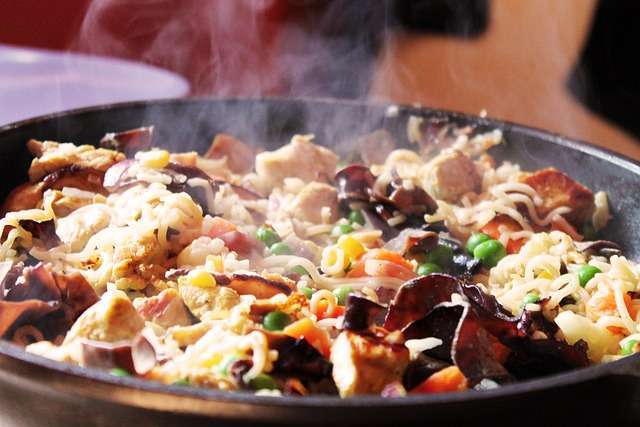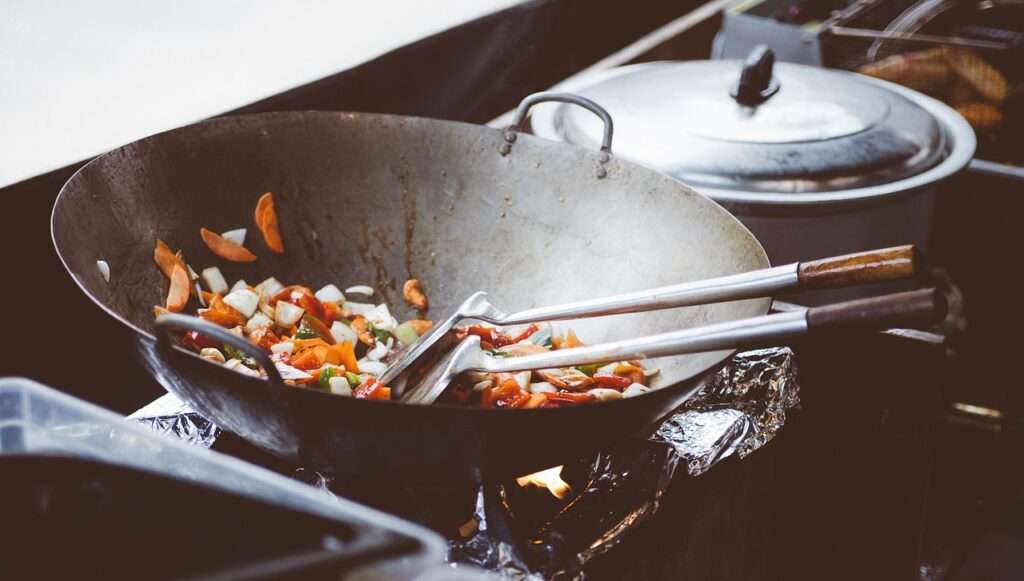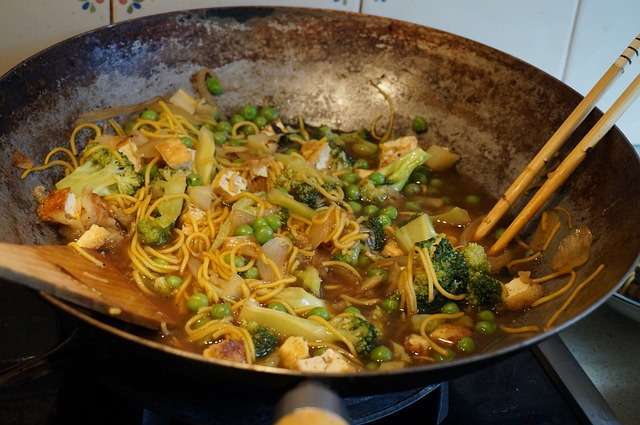Chinese culinary arts Stir-frying is one of the most important techniques of preparation in Chinese cooking, acknowledged for few other ways for the consistently colorful, delicious meals cooked in minutes. This method allows the maintainance of the color and texture of the ingredients and adds to their natural flavors. This ultimate guide will inform you everything you need to know about stir-frying in Chinese cuisine, from selecting the right ingredients and equipment to mastering techniques and tips for creating delicious meals.
Table of Contents
What is Stir-Frying?
Essential Equipment for Stir-Frying
Choosing Your Ingredients
Mastering Techniques for Stir-Frying
Commonly Stir-Fried Recipes
Stir-Frying Tips
Conclusion

- Understanding Stir-Frying
This is a, method in which ingredients are quickly cooked in a small amount of hot oil. The technique originated in China and has influenced many kitchens the world over. Unfortunately, Chinese stir-frying aside, this particular method really gives an amazing feeling of comfort in the kitchen, the convenience of cooking some delicious dish a matter of a few minutes. Chinese Culinary Arts
Some Benefits of Stir-Frying
The short cooking time: Most stir-fry recipes take less than 15 minutes to prepare.
Preservation of nutrients: Because stir-fry is cooked over high heat and does not last long, it preserves nutrients in vegetables.
- Key utensils for stir-frying
Chinese Culinary Arts The proper equipment, perhaps the most important factor in stir-frying, would be:
Wok
The most significant vessel used in stir-frying. The wok gets its unique shape because of its design, which allows heat to distribute evenly while very generously provides a surface area for tossing ingredients. Traditional carbon steel woks retain heat best; however, novice cooks may have better luck using nonstick types.

Spatula
Long-handled spatula or wok turner is essential for tossing the foods without spattering oil. Use a wooden or silicone spatula so it will not scratch the wok.
Table of Contents
Heat
Stir-fry calls for a strong flame, hence the recommended heat source is a gas stove. Otherwise, if using electric, a higher-wattage version should be acquired in order to allow enough heat to be generated.
- Choosing the Ingredients
The choice of ingredients will affect the mastery of stir-frying but is based on:
Protein
Some common proteins are chicken, beef, pork, shrimp, and tofu. If the proteins are uniformly cut, they will therefore cook evenly. Chinese Culinary Arts
Vegetable
Chinese Culinary Arts Crisp fresh vegetables that will stay crisp during cooking. Suggested are bell pepper, broccoli,sugar-snap peas, and carrot-they should be cut into bite-size pieces for ease in cooking.
Aromatics and sauces
Aromatics, such as garlic, ginger, and scallions, should be able to give your stir-fry dimension, while sauces such as soy sauce, oyster sauce, and hoisin sauce normally add up to the body.
- Mastering Your Techniques for Stir-Frying
Now with gear to go and ingredients readies, it is now time to master the techniques of stir-frying.
Prepping Your Ingredients
Before the cooking begins, it is important that all your ingredients are ready. Soak and chop vegetables, marinate proteins, and measure your sauces. Such mise en place allows for seamless cooking.
Quality and Quantity of Oil
Start the monster wok, properly preheating. Pouring oil into the hot wok is best done with oils that have high smoke points, usually vegetable or peanut oil. Swirl in the oil to coat the wok evenly.
Order of Cooking
The order in which you add ingredients is crucial. Proteins should be cooked first until browned and cooked throughout, then removed from the wok. Next, stir-fry your vegetables, adding aromatics near the end for maximum flavor. Finally, return the proteins to the wok and add your sauces.
Tossing and Stirring
Chinese Culinary Arts With a spatula, keep tossing all the ingredients. This will ensure that they cook evenly without getting burnt. The idea is to sear the ingredients without losing tenderness.
- Common recipes in stir-frying
Just now that you know the theory behind the practitioners, here you have little of classic stir-fries that are going to help you into it. Chinese Culinary Arts
Chicken and Broccoli Stir-Fry
Ingredients:
Whole chicken breast sliced
Fresh broccoli florets
Minced garlic
Soy sauce
Oyster sauce
Instructions:
Pour some oil into the socket and brown the chicken.
Then put in broccoli and minced garlic and keep stir-frying until the bright green is achieved.
Pour in the sauces and stir for about two minutes.
Beef and Bell Pepper Stir-Fry
Ingredients:
Lean beef cut into strips; strips of bell pepper; minced ginger; soy sauce; hoisin sauce.
Heat oil in a wok and sear the beef, then remove.
Stir-fry bell pepper strips and minced ginger; add sauces and toss in the beef.
Toss and serve hot; serves four.
Tofu and Veggie Stir-Fry
Ingredients
Cubed firm tofu
Mixed veggies like carrots, snow peas, and bell peppers
Garlic, ginger
Soy sauce
Instructions
Brown the tofu in oil until golden, then set aside.
Stir-fry veggies in garlic and ginger; add tofu back with soy sauce.
Toss and serve hot.
Chinese Culinary Arts

- Tricks of the Trade: Stir-Frying.
To do best, always: Chinese Culinary Arts
1-Prepare beforehand.
Always make sure that everything is prepared before you actually start cooking: you won’t have time to chop while cooking, indeed stir-frying is a matter of speed.
2-Don’t crowd the wok.
If you want to do it in one batch or another. When too crowded, your food may steam, rather than stir-fry; hence the non-crispness and blandness in flavor.
3-Heat.
Adjust the heat during cooking accordingly. If you are too hot, the food will burn; if not hot enough, they would get soft.
4-Work with flavors. Chinese Culinary Arts
Experiment with sauces and spices. Try combining different selections to please your own palate. - Conclusion
This culinary finesse for Chinese stir-frying, for the most part, rests in just some knowledge of the ingredient itself and that of flavor. Chinese Culinary Arts This essence is what makes it such an accepted and popular method of cooking. You will soon be surprised at how a delicious stir-fry just falls into place tight within your time range. Gather ingredients, heat that wok, and jump right into the stir-frying adventure! Chinese Culinary Arts
Stir-Frying, known as “chao” (炒), is one of the fundamental cooking techniques based mostly on this specific method in Chinese cuisine. It is fast cooking using high heat. Stir-frying is an excellent method of cooking healthy, nutrient-packed meals because only a small amount of oil is used and ingredients are only partially cooked, which retains their structure, color, and nutrients. Once you have learned this cooking method, you will soon become an expert.
- Select Your Wok and Tools. An effective wok should quickly heat up and accommodate a fair amount of ingredients. The wok is broad in scope and deep in the center so that it can guarantee easy tossing and even cooking.
Wok: The carbon steel woks are fast and the traditional resourceful ones for stir-frying, which heat up quickly and hold in heat. Avoid the stainless or non-stick woks; they do not perform well under high heat.
Tools: Use a spatula with a flat edge, good for stirring food and scraping food from the sides of the wok.
- Prepare in Advance All Ingredients. That is what we call “mise en place”-everything cut, chopped, measured, and set within arm’s reach so they can be added, one after another, in quick succession.
Vegetables: Clean them up, dry them, and cut them uniformly. Hard vegetables-make them thinly sliced, while soft vegetables, like leafy greens, can remain whole. Chinese Culinary Arts
Proteins: Prepare the meat or tofu in bitesized pieces to enable quick cooking, thus allowing the starch to bond with the juices.
Aromatics: Regularly slice the ginger, garlic, scallions, et cetera into very thin pieces so that their flavor may release quickly into the hot oil. Chinese Culinary Arts
Sauce: These sauces for stir-frying are usually simple ones derived from soy sauce, oyster sauce, some rice wine, and sometimes a little sugar. Mix liberally.
Stir-frying is more than a cooking technique; it is a means of connecting with the rich cultural heritage of Chinese culinary arts, where simplicity meshes with depth of flavor and nutrition. If you learn the basic principles of stir-frying-one about fire or heat control, preparation of all the ingredients, and the timing of eyes, ingredients will yield a remarkably splendid, fresh, and healthful dish.
But stir-frying is more about achieving balance and harmony: that of taste, texture, color, contrasting crisp vegetables and tender proteins harmonized by an aromatic chord from garlic, ginger, and scallions-also let’s not forget per the principles of Chinese health and well being: good quality will be wholesome.
So, basically, stir-frying not only gets the work done quickly and simply but adapts according to one’s convenience. The more comfortable one is with stir-frying, the more combinations of ingredients, sauces, and spices can be off-the-cuff and allow individual creativity to flow from food speculation. It is the wonder of wonders for busy days, giving wholesome meals in no time-flat category- from all kinds of Chinese recipes to creative adaptations that let you explore flavors from around the world with your distinctive twist.
At its core, stir-frying emphasizes the balance and harmony of taste and texture. The combination of crunchy vegetables, tender proteins, and aromatic hints from ginger, garlic, and scallions results in a wholesome and harmonious meal that matches traditional Chinese principles of health: for flavor, feel, and nutrition at a.m.a.m.-or-more-flavors-and-less-another-way,” things fishy-this one Wholesome is in full force. Chinese Culinary Arts
In learning how to stir-fry, you are embracing a practice where flavor, culture, and tradition all converge: from a basic vegetable dish to an ultimate stir-fry with meat, tofu, and many spices, every dish has come to signify a tribute to the exceedingly diverse history of Chinese cuisine, in time, practice, and through some imagination; Chinese Culinary Arts fresh ingredients transpired from palates will equate to years-old artistry of Chinese cooking. Have fun with your journey into stir-frying; it has been an adventure in talents.

Pingback: Best Top 10 Chinese Organic Baby Food Brands